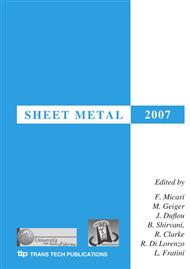p.243
p.251
p.259
p.269
p.277
p.285
p.293
p.301
p.309
The Effect of Sheet and Material Properties on Springback in Air Bending
Abstract:
Angle control in air bending is achieved either by exploiting direct angle measurement (adaptive forming) or by controlling punch displacement. In general, the desired angle is supplied as input to CNC press brakes and the choice of punch stroke relies on either analytical or empirical models. Process geometry and material properties affect the outcome, therefore, full knowledge of these values is critical. Since a major source of inaccuracies is due to errors in material description (sheet thickness is critical as well), material data (or, more generally, sheet behavior information) collection in process is advisable. In air bending, process control can be improved by studying the total load as a function of punch displacement. This approach becomes more and more interesting since devices for load measurement are now available on the market. The aim of this work is to analyze some experimental load measures, collected in actual working conditions, to evaluate the accuracy of such technique and its potential for in process applications. Several sheet materials (ferrous and non-ferrous alloys) are studied through both bending and tensile tests; the resulting material properties (tensile and bending) are evaluated and compared. After data treatment of punch force signal, the ability of predicting punch displacement needed to reach a defined bending angle (after springback) is discussed.
Info:
Periodical:
Pages:
277-284
Citation:
Online since:
July 2007
Keywords:
Price:
Сopyright:
© 2007 Trans Tech Publications Ltd. All Rights Reserved
Share:
Citation:


